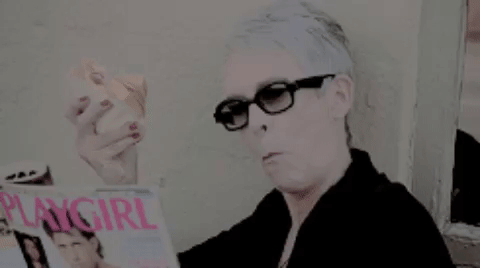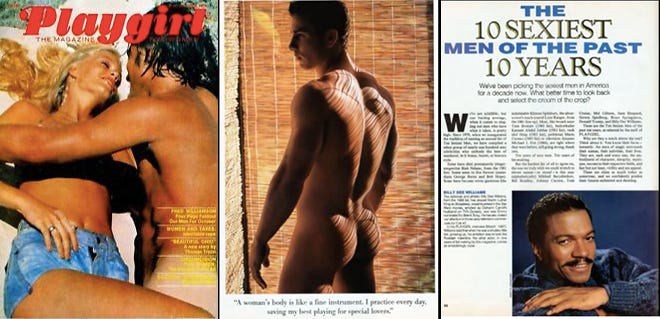Issue #11: A NSFW timeline of Playgirl’s rising & falling feminism 🐰

April 1, 2018

Hello, bunnies.
After a week that saw one of America’s biggest consumerist giants ban Cosmo from checkout lines (while still selling guns), we bring you our Playgirl edition.
An edition about a 70’s-era sex magazine aimed at women (and consumed by gay men) is especially relevant in the year of our lord 2018. Our society is immersed in one of the biggest reevaluations of safe, consensual and pleasurable sex in light of Me Too — yet our country has been having these conversations for decades.
On sex, we tend to agree with New York’s Maureen O’Connor: “To stop sexual abuse, we need to be comfortable talking about sex.” We need to evaluate how we codify sexuality and understand the politics behind how we react to a cis het man with half a hardie versus the naked female body.
Enjoy responsibly,
N & D

A slightly finger-wagging video on Playgirl's feminism
a fine-line history
In 1973, the Supreme Court ruling Roe v. Wade legalized abortion, the Watergate hearings were just beginning, and Playgirl magazine published its first issue. The nudie adult magazine based in Los Angeles was founded by night club owner Douglas Lambert. On the heels of a legendary spread of Burt Reynolds in Cosmo, Playgirl was formed as a feminist response to Playboy, a media empire founded by Hugh Hefner two decades earlier.
The magazine was envisioned as an “envelope-pusher, where women could indulge in both eye candy and mind candy.” Editorially, Playgirl was successful, selling more than 600,000 copies of its first issue, eventually exceeding a circulation of one million readers, in more than three dozen countries. Despite a lineage of male publishers, Playgirl’s first editor Marin Scott Milam was quite the siren, telling The Milwaukee Journal that her reader “is her own person first,” compared to Cosmo’s “desperation” for men.
Milam’s commentary on women magazines generally, in conversation with The Harvard Crimson in 1974, is also interesting: “The trouble with women’s magazines in the past is that they have been relentlessly one-dimensional, recognizing only a woman’s acceptable lighter side, refusing to acknowledge her sexuality, her anger and her tears. I’ll be damned if Playgirl falls into that trap.”
After over three decades, the magazine folded in 2008 in what the New York Times described as an “unremarkable," low-profile end (despite the NYT treatment). Its DIY-spirited staff had survived big cuts to funding, with editor Jessanne Collins starting a Wordpress blog when they were denied finances for a website. According to a Splinter report, the magazine still exists either quarterly or biannually in print (though is sold almost nowhere), and a live, infrequently updated website caters to a mostly gay audience. — N

(source: Ebay, Youtube)
for the gays or the gals?
The answer: both — but the scales tip toward men over time.
Playgirl was launched as a magazine for women. It’s mission statement outlined its goals of featuring “nude centerfolds alongside hard-hitting features by and for women.”
It gained a large gay following though, especially for closeted men who could say they are buying in the supermarket for their girlfriends.
Publisher Ira Ritter said he actively tried to not feature gay men in the magazine, and Dian Hanson (who Playgirl tried to hire as an editor) described the attitude amongst men running it in 1991 as still very much “[w]e don't want to make a magazine for men to jack off to."
The attitude shifted in the 2000’s, with editor-in-chief Nicole Caldwell (2006-2008) saying she answered ‘yes’ when people asked if it’s a gay magazine. The magazine is finito, but its website today features a “Gay” tab and hardcore gay porn on the homepage (but no hetero porn).
Whether chasing the gay guy or female audience, there was a lot back and forth over the years in what readers wanted out of their sexy magazine. Soft dicks? Hard dicks? Hairy butts? Big butts? In all seriousness though, how you imagine and depict the idolized/sexualized male body is a political act.
Take, for example, Dian Hanson’s quote about sex mags using stars and models of color infrequently: “I can imagine the older white men running Playgirl thinking, ‘White women don't want to see that,’ when deep down they really thought, ‘We don't want to know that white women want to see that.’” — D

Playboy had a series of "video magazines" in the '80s, so Playgirl followed up with their own take. Their videos featured lots of shirtless dudes, interviews, and segments on “women’s influence in the political arena" and closet chauvinists.
why aren't we dicks to people who show off their dicks?
In researching this issue, I was really struck by a quote from Playgirl photographer David Vance: “It was fairly easy to get people to pose nude right off the street. I only remember one model who was reluctant to show his penis.”
Why is that? Is it because men don’t have to be afraid to appear naked and sexualized, whereas appearing naked as a woman means to sacrifice your modesty, and this society treats you like you’re nothing without that good girl grace? People get outraged about women breastfeeding in public, but Greg Louganis (Olympic gold medalist, August 1987 model) said his mom showed off his nudes at her bridge club — crowing, "This is my son."
Esquire said Playgirl’s true legacy is the way it normalized sexually objectifying men, but it feels like a different brand of sexual objectification.
We view Playboy bunnies as permanent harlots and Playgirl models as regular dudes, like ‘this was just a funny thing that they did and we won’t let it define their life and worth.’ To argue against that, Hanson told BBC News that Playboy used to be a respectable place for women to "show themselves off.” She called it “a poor girl's pageant, grandmothers would approve.”
I see more layers to the convo. A friend and I groaned last night at the bar about how men can be smart and sexy, but some people still act like women can’t also be both. Sexy male teachers get modeling contracts, sexy female teachers lose their jobs.
In Playgirl’s case, maybe the reception has to do a bit with the audiences. Queer culture tends not shame sexuality and desire as much, and women don’t share the urge to belittle someone and assert their own higher status before they consider that person fuckable. Even when they want to bottom, guys need to be on top. —D

for further reading
She Picks the Men Who Pose In Magazine’s Centerfold - New York Times, 1973
When Playgirl Readers Demanded More Full Frontal - The Atlantic/Wire, 2013
What I Learned When I Posed for ‘Playgirl’- Medium, 2008
Thanks for reading, and hit us up! We want to know your memories with magazines, including what you loved and hated. And if you’ve never read a women’s mag, welcome. Send notes and scans: clippedmagazines@gmail.com.

